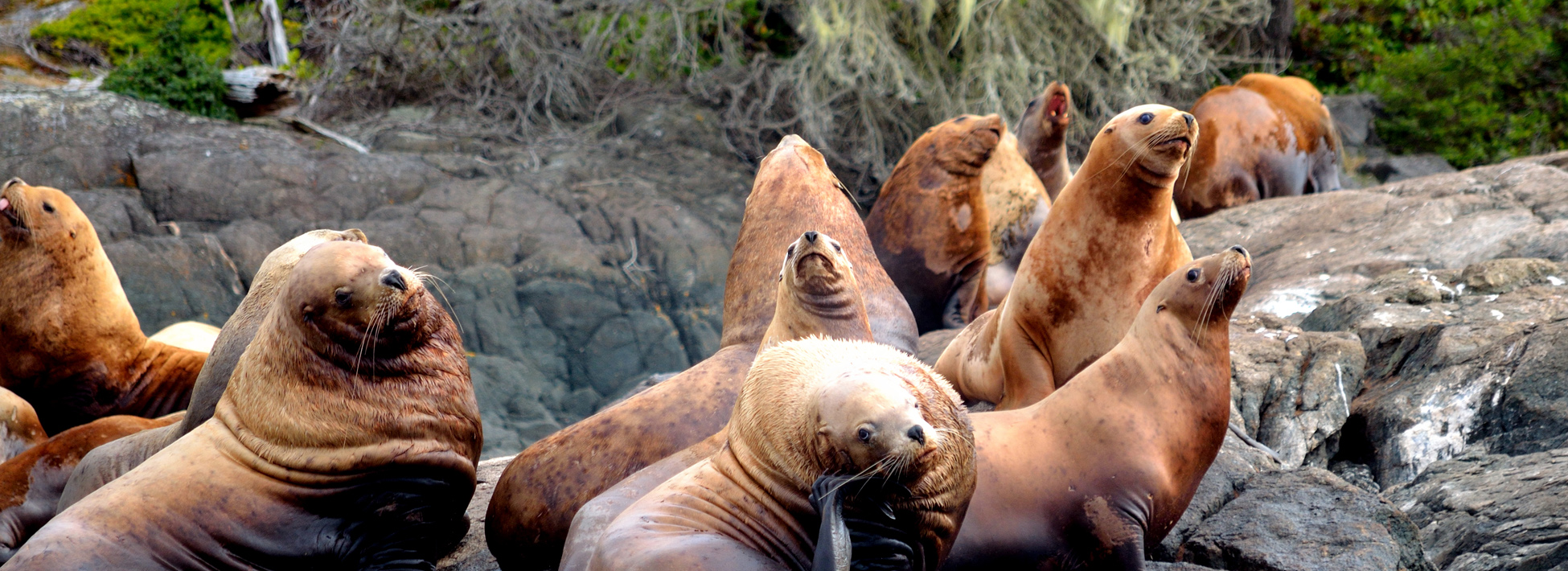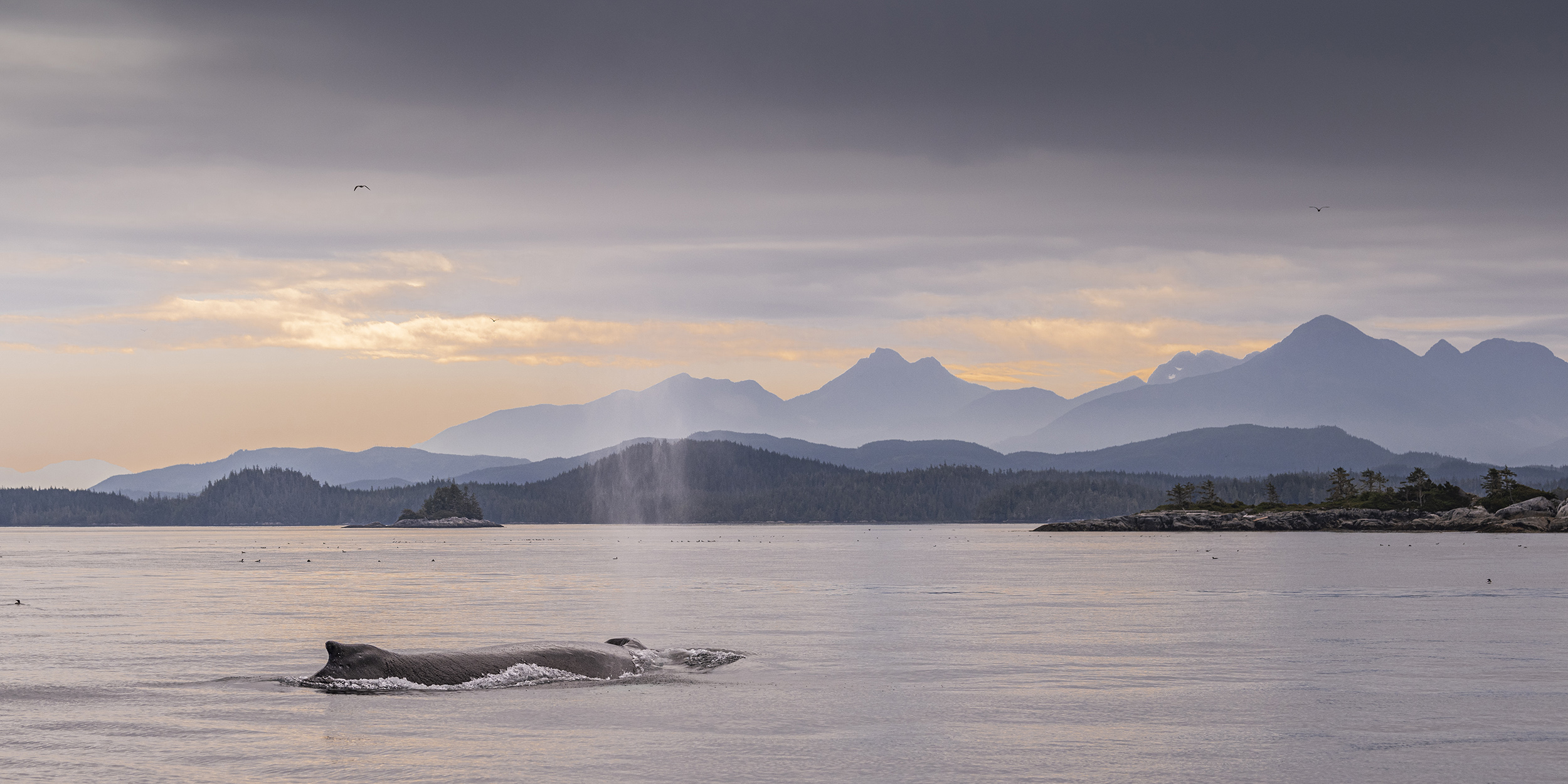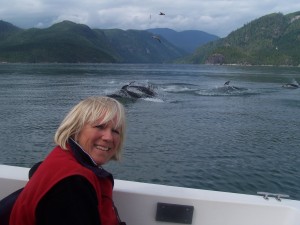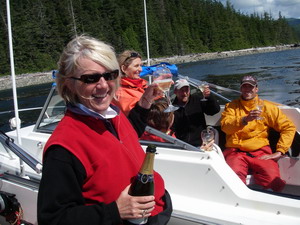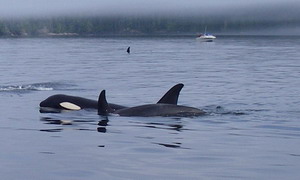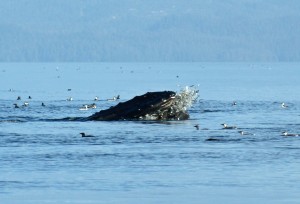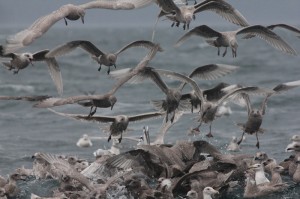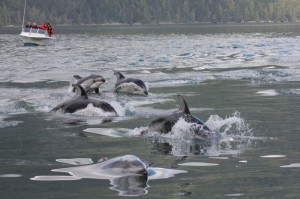On our whale watching safari we try to eat lunch at an interesting location normally in the area of the sea lions or humpback whales in the waters off Telegrahp Cove on Vancouver Island. “There is nothing like French champagne to celebrate these three marvelous days in August, plenty of dolphins, orcas, grizzly, salmons, black bears, seals, great friendship and with particular thanks to our two outstanding guides.” (Note the champagne was brought from France for your picnic lunch in the boat.) Nicole et Jean Martin-Dondoz of Marseille France provide pictures and comments.
Whale Watching
We’re not all about the bears, whales are abundant here too!
Killer whales and humpback whales are often seen during our wildlife tours. There are resident whales and transient whales that can be seen feeding and playing in our waters.
Whale Watching Safari
Harold Bailey from the UK who was with us the first week of September, provided the comment and picture “I feel lucky tonight”. Whale watching safari trips from the lodge include more than humpback whales and orca. The water-ways between Vancouver Island and the BC mainland abound in marine based wildlife: eagles, large variety of ducks and water fowl, white-sided dolphins, dall’s porpoise, harbour porpoise, harbour seals and of course stellar sea lions. A safari trip without viewing a majority of these is not considered a good day.
Orca Watching?

Spyhoping is an action taken by orca to get a better view of their surroundings. Although most books published on whale / orca behaviour show many pictures of this activity it is very hard to get a picture. If you have your camera pointed in the right direction and happen to be taking a picture on another orca activity you might just get a spyhop.
Whale identification
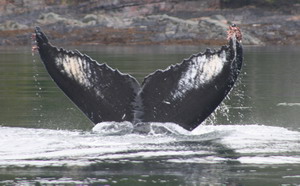
Many of the humpback whales we observe in the waters of British Columbia have been identified with a number / name and have their pictures in a catalogue. The underside of a whale’s tail shows a range of white patterns. These patterns added to any scars or other markings are unique to each whale.
Orca watching safari
The whale / orca watching requires a short run to Johnstone Strait in the area of Telegraph Cove on BC’s Vancouver Island. Guidelines are in place to prevent whale harassment but that does not mean that we don’t manage to obtain good photos. Orca being curious will frequently investigate us while we watch them.
Black Bear while Whale Watching
Wildlife viewing is where you find it and many of the black bears we find are on whale watching trips. This black bear has done a good job of putting on weight over the summer. He is in good shape for the coming winter. This one was not going swimming rather was concentrating on getting more muscles and barnacles from the rocks before the tide rose.
Whale watching in BC
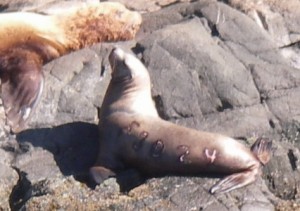
Watching Humpback Whale Lunge Feeding
“Humpback whales often feed by lunging – moving quickly toward a school of prey with their mouths wide open, then closing their mouths and filtering the salt water out using their baleen. Researchers at the University of British Columbia learned from tagging humpback whales that during these lunges, the whale drops its lower jaw, creating drag that helps fill its mouth with prey and water. The effective, but energetically-costly feeding technique explains the relatively short dives humpback take while feeding.” a quote from Jennifer Kennedy, About.com Guide. Gary Wilson from Australia captures this feeding whale in Blackfish Sound not far from Vancouver Island’s Telegraph Cove. On normal whale watching safari day with an incoming tide to bring the herring into the viewing area we will see several humpbacks feeding.
Whale Watching while seagulls feed
A herring “ball” results when a school of herring is chased to the surface by a predatory fish, ducks or other diving birds. Often the herring balls can be spotted by a large flock of seagulls noisily feeding on the surface. Spotting the gulls feeding is a joy for your guide as the unenviable fate of the herring is to be dinner for a larger mammal meaning humpback whales. As a guide once the herring ball is located the intent is to stop the boat in proximity of the gulls and wait. “Keep your eye on the gulls and as they lift into the air get ready for a picture of a whale lunge feeding”(see tomorrow’s blog) is the directions given to the guests while we wait. James O’Donoghue’s photo captured the mass of the gulls but not the noise they produce. The area for the lodge’s whale watching safari day is Blackfish Sound not far from Vancouver Island’s Telegraph Cove. It is an area known for the abundance of herring and thus popular for salmon fishing which also means orca that feed on the salmon.
Whale Watching and Pacific White-side Dolphins
I cannot think of another photo that I have posted of white-sided dolphins, which tells a more complete story than this one from James O’Donoghue. On tour days we frequently travel with another boat from the lodge when we run to Johnstone Strait near Telegraph Cove to look for whales thus the picture of one of our boats in the back ground. Notice the warm “floater” suits the guests wear while on the water. Even though this is summer it is cool on the water in the morning. Also it is easy to pick out the guide without the suit as we tend to be climatized to the weather. The most amazing aspect of the photo is the fact that it shows every stage of white sides’ “porpoise” (short term for the way dolphins come out of the water when traveling in a hurry). It shows them first breaking out of the water to clearing the water and then their returning dive. Also note the calm water surrounding the ripples indicating there are likely several hundred dolphins keeping the water churned up as they pass close to our boat.
